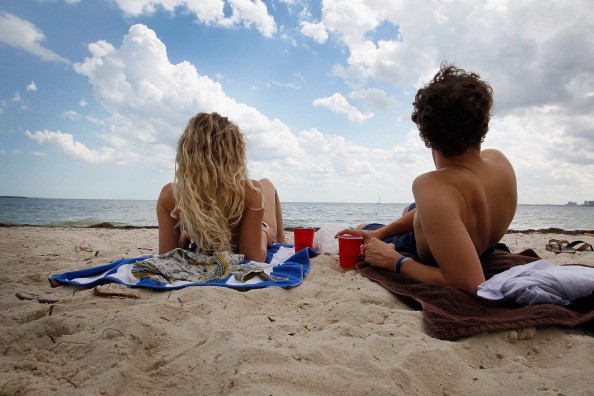Beach Sand May Contain More Harmful Bacteria Than The Polluted Seawater
| Staff Reporter | | Jul 18, 2015 07:13 AM EDT |
(Photo : Photo by Joe Raedle/Getty Images) Sand in the beaches could be carrying more pathogenic bacteria than polluted water in the seas reported researchers from the University of Hawaii in a study published in Environmental, Science and Technology journal.
Sand in the beaches could be carrying more pathogenic bacteria than polluted water in the seas reported researchers from the University of Hawaii in a study published in Environmental, Science and Technology journal.
Some people think that it is safe to remain in the sand and watch the sea though beaches are closed of water pollution which the researchers warn as a bad idea. The investigators explain that harmful bacteria that cause gastrointestinal infections and diarrhoea remain in the beach sand for long time than they do in sea water, reported Abc News.
Like Us on Facebook
It is observed that the beach sand contains abundant pathogenic bacteria like E. coli indicating the faecal contamination, noted the researchers. They also added that various studies carried out by scientists for over a decade now have shown that bacteria from faecal contamination in the beaches are 10 to 100 folds higher than that of the water present nearby, reported CBS News.
Tao Yan, the lead author of the study from University of Hawaii at Manoa said that the waste-water contaminated beach sand acts as a source of faecal bacterial contamination to the beach sea-water.
According to the researchers, "The different decay rates of wastewater bacteria in beach sand and seawater indicate that beach sand needs to be considered carefully in assessing its impact on water quality monitoring and public health," noted Abc News.
Dr. William Schaffner, an infectious disease expert from Vanderbilt University Medical School, noted that the study is of great use for public health experts to determine if the beaches are safe for people since the focus now is on both, the water and the sand, reported Observer Chronicle.
Schaffner explained, "There's a dynamic interface between water and sand. Faecal indicator bacteria...die off more quickly than they do in the sand, at least some of them do. The sand likely keeps feeding and reintroducing indicator bacteria into the water."
He also added: "This is not trivial because there are many communities in the world where wastewater is...introduced into bodies of water." Schaffner noted that the study "gives us much more sophisticated sense of how long natural environment takes to clean up."
TagsBeach, Beach sand, Fecal contamination, gastrointestinal infection, diarrhea
©2015 Chinatopix All rights reserved. Do not reproduce without permission
EDITOR'S PICKS
-

Did the Trump administration just announce plans for a trade war with ‘hostile’ China and Russia?
-

US Senate passes Taiwan travel bill slammed by China
-

As Yan Sihong’s family grieves, here are other Chinese students who went missing abroad. Some have never been found
-

Beijing blasts Western critics who ‘smear China’ with the term sharp power
-

China Envoy Seeks to Defuse Tensions With U.S. as a Trade War Brews
-

Singapore's Deputy PM Provides Bitcoin Vote of Confidence Amid China's Blanket Bans
-

China warns investors over risks in overseas virtual currency trading
-

Chinese government most trustworthy: survey
-

Kashima Antlers On Course For Back-To-Back Titles
MOST POPULAR
LATEST NEWS
Zhou Yongkang: China's Former Security Chief Sentenced to Life in Prison

China's former Chief of the Ministry of Public Security, Zhou Yongkang, has been given a life sentence after he was found guilty of abusing his office, bribery and deliberately ... Full Article
TRENDING STORY

China Pork Prices Expected to Stabilize As The Supplies Recover

Elephone P9000 Smartphone is now on Sale on Amazon India

There's a Big Chance Cliffhangers Won't Still Be Resolved When Grey's Anatomy Season 13 Returns

Supreme Court Ruled on Samsung vs Apple Dispute for Patent Infringement

Microsoft Surface Pro 5 Rumors and Release Date: What is the Latest?













